There are a lot of misconceptions and
misunderstanding about how the moon and its cycles actually behave. The moon
is not a nightlight that rises at sunset and sets at sunrise and provides
light all night when the sun is down. It only rises at sunset and sets at
sunrise when it's full. At other points in its cycle, it can rise or set at
any time of the day or night, or be high in the sky at any time of day or
night, all depending on its phase. When it's near new, it'll actually rise
and set with the sun, and be in the sky all day... though it'll be difficult
to see, because it'll be mostly dark and appear very close to the brilliant
glare of the sun.
So to understand what it really does and why, let's take a look at how
the mechanics of the thing actually work.
This
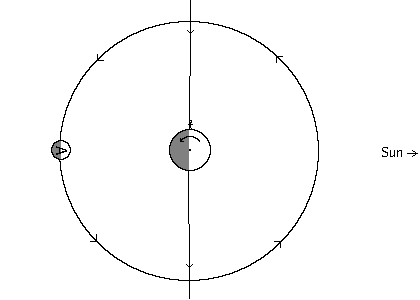 is a system like Earth-Luna. We're looking down at it from above the
North Pole. The sun is some distance off the right edge of the diagrams,
lighting everything from the right. The planet rotates counterclockwise,
making one full turn each day. The moon revolves around the planet, also
moving counterclockwise, but much more slowly... one complete revolution
every month.
is a system like Earth-Luna. We're looking down at it from above the
North Pole. The sun is some distance off the right edge of the diagrams,
lighting everything from the right. The planet rotates counterclockwise,
making one full turn each day. The moon revolves around the planet, also
moving counterclockwise, but much more slowly... one complete revolution
every month.
The whole planet-moon system is also moving counterclockwise around the
sun, even more slowly - once per year - but we'll ignore that; it's not
really relevant to what we're looking at here.
We have a stick-figure observer (not to scale; none of this really is)
standing on the planet looking at the sky. We'll say he's at the planet's
equator, and his planet has no significant axial tilt, so we don't have to
worry about some complicating issues that aren't really relevant here. This
also means that day and night will each be twelve hours long, with the sun
rising at about 6 AM and setting at about 6 PM.
It doesn't really matter where on the equator our observer is
standing... because the planet rotates so much faster than the moon revolves
around it, or it revolves around the sun, longitude just causes a time zone
effect. The sky our observer sees now is very nearly the same sky that
someone ninety degrees east of him saw six hours earlier, or someone ninety
degrees west of him will see six hours hence.
We'll also assume that the weather is always clear in the tropical
paradise he lives in, and the horizon is uncluttered, so he can always see
everything that's there to be seen in the sky.
So as we look in on our observer here, what is that sky he sees? Well,
he's standing right on the terminator, the line that divides day and night.
West of him, the planet's lit by the sun, while east of him the planet is in
its own shadow. He's being carried eastward into night by the rotation of
the planet. That means that it's sunset, and looking at the diagram, we can
see that the sun is going to be low on his western horizon. In the other
direction, the moon is low on his eastern horizon, and he's rotating towards
it, so that means it's rising. The side of the moon towards him is the side
of the moon towards the sun, so it's fully lit - a full moon.
Now, the moon looks like it should be in the planet's shadow - and it
might be, which would make it a lunar eclipse - but it probably actually
isn't. The diagram isn't in scale, the distances between the bodies should
be much larger than they appear, and, in three dimensions, the planes of the
orbits probably don't quite line up, so the moon's likely to actually be a
little above the planet's shadow, or a little below its shadow, but probably
not quite in it - which is why we don't have a lunar eclipse
every full moon, but only once in a great while when everything
happens to line up perfectly.
So
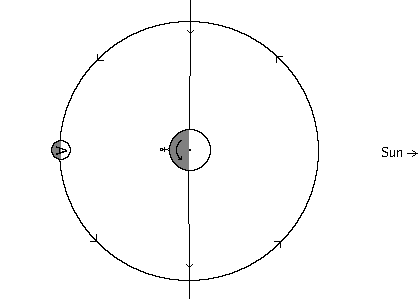 now we'll advance a few hours into the future, to our stick figure's local
midnight. He's still standing in the same spot looking at the sky, but the
planet has rotated ninety degrees, carrying him with it. It's full night now
where he is, with the sun out of sight on the opposite side of the planet.
The moon, slow-moving as it is, has also stayed in very nearly the same
spot, but because the planet is rotating beneath it, it's now directly over
our observer's head. The face of it that's towards the planet is still the
face that's lit by the sun, so it's still a full moon.
now we'll advance a few hours into the future, to our stick figure's local
midnight. He's still standing in the same spot looking at the sky, but the
planet has rotated ninety degrees, carrying him with it. It's full night now
where he is, with the sun out of sight on the opposite side of the planet.
The moon, slow-moving as it is, has also stayed in very nearly the same
spot, but because the planet is rotating beneath it, it's now directly over
our observer's head. The face of it that's towards the planet is still the
face that's lit by the sun, so it's still a full moon.
A
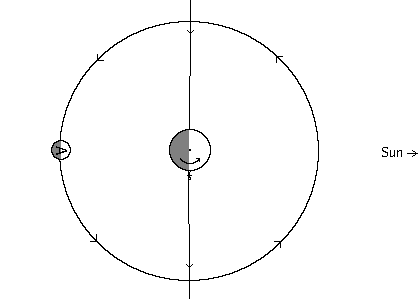 few more hours, and the rotation of the planet has carried our observer
clear around to the sunrise line. This has brought him back to where he can
see the sun, rising on his eastern horizon, but also carried him away from
the moon, which - again, despite not actually having moved significantly in
its orbit - is now low on his western horizon, setting. And still, as
before, full.
few more hours, and the rotation of the planet has carried our observer
clear around to the sunrise line. This has brought him back to where he can
see the sun, rising on his eastern horizon, but also carried him away from
the moon, which - again, despite not actually having moved significantly in
its orbit - is now low on his western horizon, setting. And still, as
before, full.
A
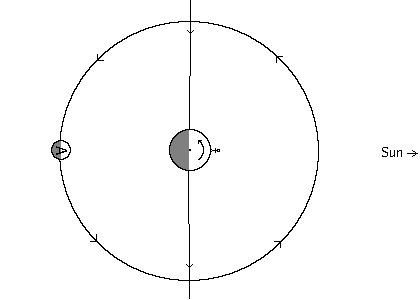 few more hours, and our observer has been carried around so he's directly
beneath the sun. It's noon where he is, bright daylight with the sun
directly overhead. He can't see the moon - it's still there, still full, but
around on the other side of the planet, shining down on the antipodes, and
there's a ball of rock and iron thousands of kilometers thick blocking his
view of it.
few more hours, and our observer has been carried around so he's directly
beneath the sun. It's noon where he is, bright daylight with the sun
directly overhead. He can't see the moon - it's still there, still full, but
around on the other side of the planet, shining down on the antipodes, and
there's a ball of rock and iron thousands of kilometers thick blocking his
view of it.
Now, so far, this looks pretty much like what I said
it doesn't do, right? Well, that's because we've only looked at the full
moon. I am, here, going to arbitarily define this system's month - the time
it takes for the moon to complete one orbit around the planet - as 32 days,
which is a bit longer than Luna's month, but which will make my
diagram-drawing easier later on.
So
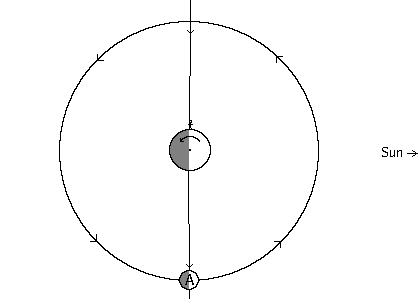 we're going to advance our clock by eight days here. Given the 32-day month,
that means that the moon will have traveled a quarter of the way around its
orbit. It's sunset again, and Mr. Stick Figure is standing in his usual
spot, looking at the sky. We can see, again, that he's at the terminator,
being carried from day into night by the planet's rotation. The sun is low on
his western horizon... but the moon is not rising as the sun sets. It is, in
fact, nowhere to be seen. It's moved in its orbit so it's no longer directly
opposite the sun, which means that when the sun sets on our observer, the
moon is clear around on the other side of the planet where he can't see
it.
we're going to advance our clock by eight days here. Given the 32-day month,
that means that the moon will have traveled a quarter of the way around its
orbit. It's sunset again, and Mr. Stick Figure is standing in his usual
spot, looking at the sky. We can see, again, that he's at the terminator,
being carried from day into night by the planet's rotation. The sun is low on
his western horizon... but the moon is not rising as the sun sets. It is, in
fact, nowhere to be seen. It's moved in its orbit so it's no longer directly
opposite the sun, which means that when the sun sets on our observer, the
moon is clear around on the other side of the planet where he can't see
it.
Our
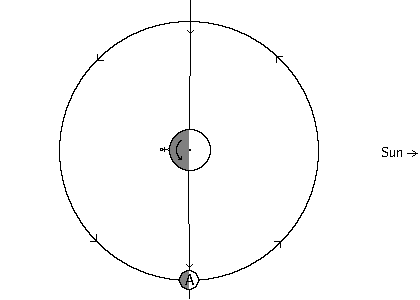 observer waits a few hours, though, and, finally, at midnight, after six
hours of moonless night, the rotation of the planet carries him around to
where he can see the moon. It's now, at midnight, rising on the eastern
horizon. He's also no longer looking at the fully lit face. Because the moon
is beside the planet relative to the sun now instead of beyond it, the face
turned towards the planet is now only half lit, with the other half dark, in
the moon's own shadow. That makes it a quarter moon. (Yes, half-lit, quarter
moon... I didn't make up the terminology. It's because the moon is a quarter
of the way through its cycle.) Because it's waning - moving from full to new
- it is, specifically, the last quarter.
observer waits a few hours, though, and, finally, at midnight, after six
hours of moonless night, the rotation of the planet carries him around to
where he can see the moon. It's now, at midnight, rising on the eastern
horizon. He's also no longer looking at the fully lit face. Because the moon
is beside the planet relative to the sun now instead of beyond it, the face
turned towards the planet is now only half lit, with the other half dark, in
the moon's own shadow. That makes it a quarter moon. (Yes, half-lit, quarter
moon... I didn't make up the terminology. It's because the moon is a quarter
of the way through its cycle.) Because it's waning - moving from full to new
- it is, specifically, the last quarter.
Six
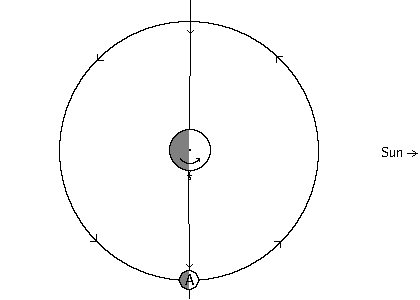 hours later, the moon has climbed high in the sky - again, not because of
its own movement, but because of the rotation of the planet beneath it. It's
directly overhead - still half-lit and half-dark - when the planet's
rotation carries our observer back around to the dawn terminator, and the
sun begins to peek over his eastern horizon.
hours later, the moon has climbed high in the sky - again, not because of
its own movement, but because of the rotation of the planet beneath it. It's
directly overhead - still half-lit and half-dark - when the planet's
rotation carries our observer back around to the dawn terminator, and the
sun begins to peek over his eastern horizon.
After
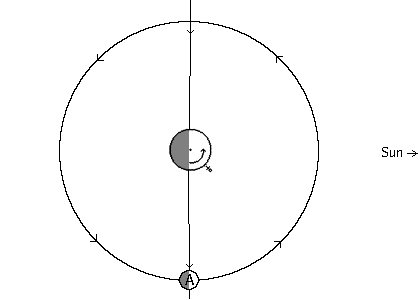 a shorter-than-usual interval - about three hours; it's about 9 AM where our
observer is - we can see that the sun is well up in his sky. It's broad
daylight now. The moon is also still well up in his sky, though
no longer directly overhead. He'll be able to see here its lit portion hanging
in a blue sky.
a shorter-than-usual interval - about three hours; it's about 9 AM where our
observer is - we can see that the sun is well up in his sky. It's broad
daylight now. The moon is also still well up in his sky, though
no longer directly overhead. He'll be able to see here its lit portion hanging
in a blue sky.
At
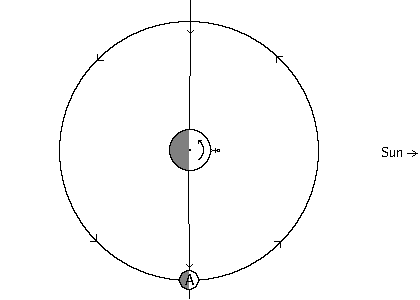 noon, when the sun is directly over our observer's head, the moon is finally
setting in the west, having been visible in the daytime sky all morning.
noon, when the sun is directly over our observer's head, the moon is finally
setting in the west, having been visible in the daytime sky all morning.
So
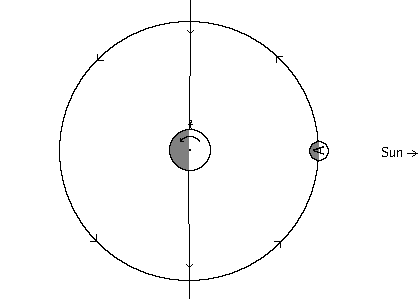 we skip ahead another eight days. The moon revolves another quarter of the
way around the planet. It's now between the planet and the sun. Probably not
directly between... like the full moon, on the rare occasions that
the new moon is directly in line with the planet and the sun, it produces an
eclipse. A solar eclipse, in this case. But usually it's not directly in
line, but a little above or below, and thus eclipses are uncommon, and don't
occur every new moon.
we skip ahead another eight days. The moon revolves another quarter of the
way around the planet. It's now between the planet and the sun. Probably not
directly between... like the full moon, on the rare occasions that
the new moon is directly in line with the planet and the sun, it produces an
eclipse. A solar eclipse, in this case. But usually it's not directly in
line, but a little above or below, and thus eclipses are uncommon, and don't
occur every new moon.
The moon is, however, in the sky very near the sun. This means that it's
on the western horizon at sunset, setting with the sun. The side of it
that's lit is the side directly away from the planet. The entire near side
is dark - a new moon.
The
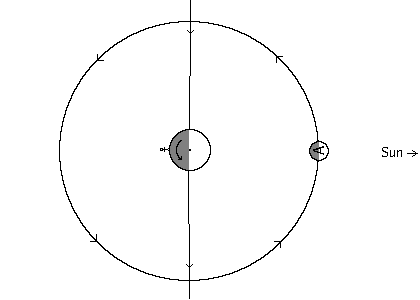 moon having set with the sun at dusk, there's nothing but the stars in the
sky at night. The sun and moon are both on the far side of the planet,
unseen.
moon having set with the sun at dusk, there's nothing but the stars in the
sky at night. The sun and moon are both on the far side of the planet,
unseen.
When
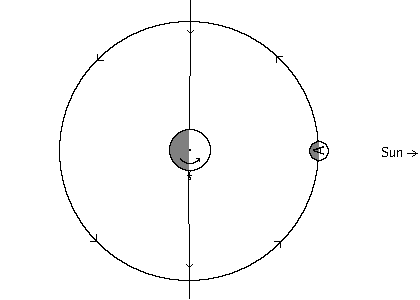 sunrise rolls around again, the moon, still near the sun in the (now)
eastern sky, rises right along with it.
sunrise rolls around again, the moon, still near the sun in the (now)
eastern sky, rises right along with it.
And
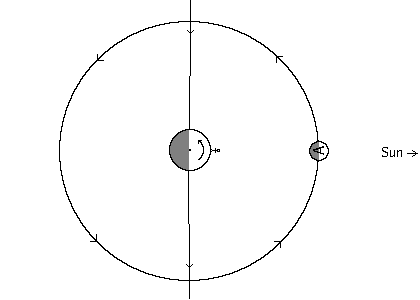 at noon, when the sun is high in the daytime sky, the moon is right there
with it, directly overhead. Because it's new, though, the lit side away from
the planet, it'll show only a thin crescent, if anything at all, and even
that is likely invisible in the brilliant glare of the sun.
at noon, when the sun is high in the daytime sky, the moon is right there
with it, directly overhead. Because it's new, though, the lit side away from
the planet, it'll show only a thin crescent, if anything at all, and even
that is likely invisible in the brilliant glare of the sun.
Another
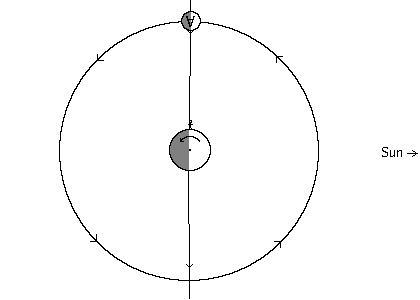 eight days will bring the moon around another quarter-turn. It's now
directly overhead at sunset, with half of it - the other half, this time -
lit by the sun. This makes it a quarter moon again (I told you, I didn't
make up the terminology here) - this time, the first quarter.
eight days will bring the moon around another quarter-turn. It's now
directly overhead at sunset, with half of it - the other half, this time -
lit by the sun. This makes it a quarter moon again (I told you, I didn't
make up the terminology here) - this time, the first quarter.
And
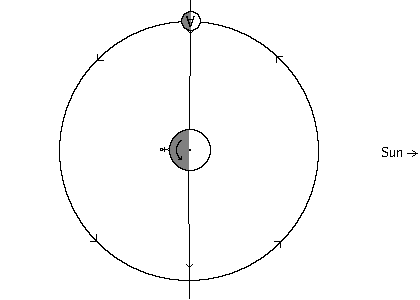 at midnight, the moon sets.
at midnight, the moon sets.
And
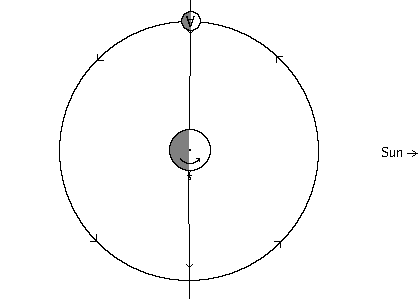 the rest of the night is moonless. When the sun rises on our observer, the
moon is on the opposite side of the planet from him.
the rest of the night is moonless. When the sun rises on our observer, the
moon is on the opposite side of the planet from him.
The
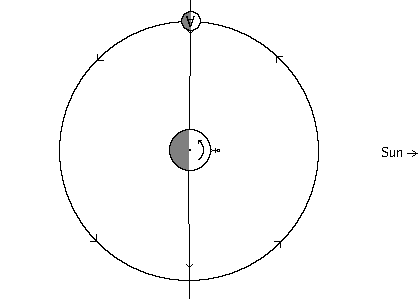 moon rises at midday, though, when the sun is directly overhead, and through
the afternoon it climbs higher in the sky until it's in turn directly
overhead when sunset rolls around again.
moon rises at midday, though, when the sun is directly overhead, and through
the afternoon it climbs higher in the sky until it's in turn directly
overhead when sunset rolls around again.
And
 in another eight days, the moon completes its orbit around the planet, and
is back to the full position, back where we started.
in another eight days, the moon completes its orbit around the planet, and
is back to the full position, back where we started.
Now, we can see several things from these diagrams.
One of these is that time down on the surface of the planet depends on the
rotation of the planet relative to a sun that's, for practical purposes,
fixed in space.
Another is that moonrise and moonset also depend on the rotation of the
planet. The moon does move in its orbit around the planet, but only slowly,
so when it rises and sets depends on when the planet turns to bring the
observer around where he can see its slowly-changing position in orbit, not
on the slow motion of the moon through space.
And another is that the phase of the moon depends not on the rotation of
the planet, but on the revolution of the moon around the planet. As long as
it's in the same part of its orbit, relative to the position of the sun,
it'll be the same phase from anywhere on the planet at any time of day - and
in any month.
Add these all up, and we can see that the time at which the moon rises
and sets is determined by its position in its orbit relative to the sun - in
other words, its phase. A moon in the same phase will always rise and set at
roughly the same time every month, and in each phase, it'll rise and set at
a different time. To wit:
- The full moon rises at sunset and sets at sunrise.
- A waning gibbous moon rises about three hours after sunset and sets
about three hours after sunrise.
- A last quarter moon rises about midnight and sets about noon.
- A waning crescent rises about three hours before sunrise and sets about
three hours before sunset.
- A new moon rises and sets with the sun.
- A waxing crescent rises about three hours after sunrise and sets about
three hours after sunset.
- A first quarter moon rises about noon and sets about midnight.
- A waxing gibbous moon rises about three hours before sunset and sets about
three hours before sunrise.
- And that brings us back to the full moon.
This is, of course, a gradual progression. Each day, the moon rises a
little later and sets a little later - a little less than a hour later, for
Earth's moon, about 45 minutes later for the example moon with its 32-day
month. This does mean that the moon moves enough in its orbit from one day
to the next that it should be visible in the diagrams, and it isn't. This is
entirely because I'm lazy.
Another thing to notice is that the moon, throughout
its orbit around the planet, has kept the top of the "A" pointed directly at
the planet... always the same side towards its planet, throughout its cycle.
Sometimes lit, sometimes dark, but always the same side. Almost all of Sol
System's major moons, including Luna, do this. It's called "tidal locking",
and, from the evidence, is pretty normal for moons. Comparing the moon's
orientation in each phase, you can see that this means that the moon has
rotated completely around exactly once over the course of its orbit. It
always keeps the same face towards the planet, but it rotates to do so... it
just rotates at the same rate that it revolves. Points on its surface
experience a day/night cycle, because it's not always keeping the same face
towards the sun, but its days are a month long. Also, from the
point of view of an observer on the moon, the planet will remain fixed at a
single point in the sky.
Now, that's one moon. What if, this being some sort
of speculative fiction world (or Mars... but Mars is more complicated),
there are two moons? Well, the moons' phases are determined, like a single
moon's, by their position in their orbit around the planet, relative to the
position of the sun. If they're in the same part of their orbit, they'll be
the same phase, and rise and set together.
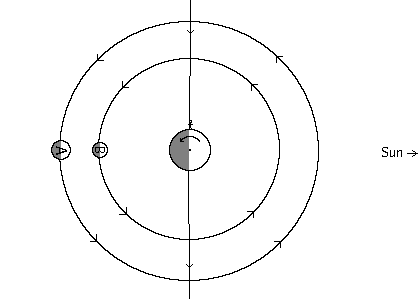
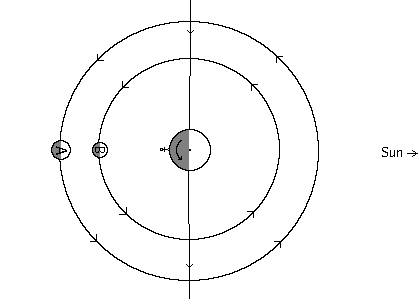
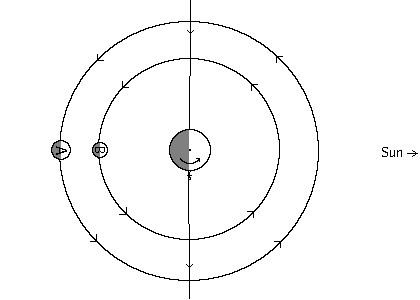 Just like our single-moon world, here both moons are full,
and rise together at sunset, set together at sunrise, and are directly
overhead at midnight.
Just like our single-moon world, here both moons are full,
and rise together at sunset, set together at sunrise, and are directly
overhead at midnight.
But... this isn't always going to be true. In fact, it won't often be
true. Because of the way orbital mechanics work, moons in different orbits
won't be moving at the same speed. The outer moon, Moon A here, will move,
in absolute terms, faster than the inner moon, Moon B. The inner moon hasn't
got as far to go, though, so despite moving slower, it'll actually take Moon
B less time to complete an orbit around the planet than it does
Moon A. It's going slower, but it's got the inside track. This means that
the only time the moons will both be in the same part of their respective
orbits is as Moon B is overtaking Moon A, and then only for a brief time
before Moon B passes and moves ahead.
And again, while it appears that Moon B is directly between Moon A and
the planet, occulting Moon A, it usually actually won't be. The angles of
their orbital planes probably aren't exactly the same, so most of the time
they'll be offset a little vertically as they pass. Even a degree of
difference is significant... Sol and Luna are each only about half a degree
across in Earth's sky, so a single degree of difference in the angle of
their orbital planes as they pass means that their near edges will be a full
Luna-width apart at their near approach.
The orbital planes do have to cross somewhere, though, so it's likely
that every so often their cycles will line up perfectly, and Moon B
will pass directly in front of Moon A. It'll happen only rarely,
though.
We've already arbitrarily defined Moon A's orbital
period as 32 days, so let's define Moon B's shorter orbital period as 24
days. (Again, numbers chosen to simplify my diagram-drawing.)
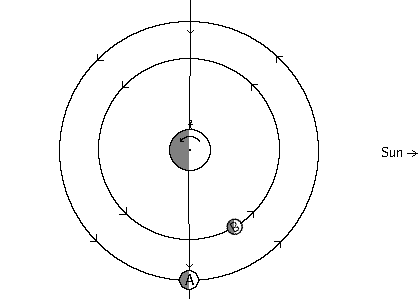 This means that eight days after the previous set of diagrams, Moon A will
have moved a quarter of the way around its orbit, and be in the last
quarter, as when it was the only moon. Eight days is a third of
Moon B's orbital period, however, so it will have moved a third of the way
around its orbit, and pulled ahead of Moon A.
This means that eight days after the previous set of diagrams, Moon A will
have moved a quarter of the way around its orbit, and be in the last
quarter, as when it was the only moon. Eight days is a third of
Moon B's orbital period, however, so it will have moved a third of the way
around its orbit, and pulled ahead of Moon A.
At sunset for our observer, neither moon is in the sky. The sun is going
down in the west, and both moons are behind the planet out of sight.
At
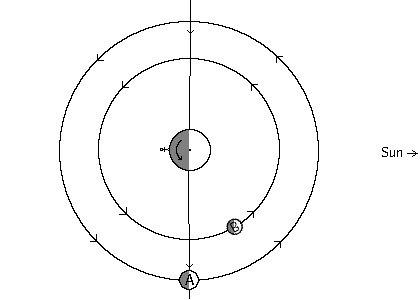 midnight, the rotation of the planet brings our observer around so that Moon
A is just rising above his horizon. As before, it's last quarter, half of
the near face lit and half of it dark. Moon B, being a little further along,
is still below the horizon, out of sight, however.
midnight, the rotation of the planet brings our observer around so that Moon
A is just rising above his horizon. As before, it's last quarter, half of
the near face lit and half of it dark. Moon B, being a little further along,
is still below the horizon, out of sight, however.
About
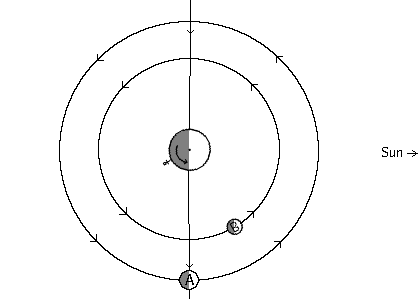 2 AM, the planet has rotated far enough that Moon B also clears the eastern
horizon. Moon A, having been up for a couple of hours, is about thirty
degrees above the horizon when Moon B is just rising. Moon B is also
somewhat past the last-quarter position. The face of it that's towards the
planet, towards the observer, is not half-and-half, but more dark than
light. It's not a quarter moon, it's a fat crescent. As it rises, we now
have two moons in our observer's sky, in different spots, and in slightly
but distinctly different phases.
2 AM, the planet has rotated far enough that Moon B also clears the eastern
horizon. Moon A, having been up for a couple of hours, is about thirty
degrees above the horizon when Moon B is just rising. Moon B is also
somewhat past the last-quarter position. The face of it that's towards the
planet, towards the observer, is not half-and-half, but more dark than
light. It's not a quarter moon, it's a fat crescent. As it rises, we now
have two moons in our observer's sky, in different spots, and in slightly
but distinctly different phases.
When
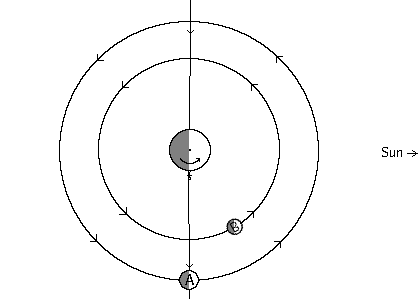 the sun rises a few hours later, Moon A is directly overhead, still at its
last quarter, and the waning crescent of Moon B is high in the eastern sky
and climbing.
the sun rises a few hours later, Moon A is directly overhead, still at its
last quarter, and the waning crescent of Moon B is high in the eastern sky
and climbing.
At
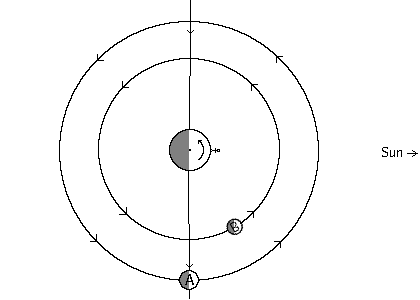 noon, Moon A sets in the west, leaving Moon B still above the western
horizon, a fat crescent with its rounded belly facing upwards towards the
sun and its horns pointed down at the horizon. Moon B follows A down a
couple hours later, as the sun is beginning to slide down the western
sky.
noon, Moon A sets in the west, leaving Moon B still above the western
horizon, a fat crescent with its rounded belly facing upwards towards the
sun and its horns pointed down at the horizon. Moon B follows A down a
couple hours later, as the sun is beginning to slide down the western
sky.
So
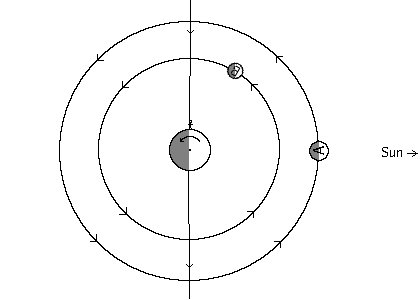 we skip ahead another eight days. This brings Moon A another quarter of the
way around its orbit to new, and Moon B another third of the way around -
almost, but not quite, to the first quarter. When our observer looks up at
dusk, Moon A, dark and invisible, is setting in the west with the sun. Moon
B is still above the horizon, and partly lit, not quite half lit. It's the
same fat crescent as eight days earlier, in fact, but on the other side
now... waxing instead of waning.
we skip ahead another eight days. This brings Moon A another quarter of the
way around its orbit to new, and Moon B another third of the way around -
almost, but not quite, to the first quarter. When our observer looks up at
dusk, Moon A, dark and invisible, is setting in the west with the sun. Moon
B is still above the horizon, and partly lit, not quite half lit. It's the
same fat crescent as eight days earlier, in fact, but on the other side
now... waxing instead of waning.
The
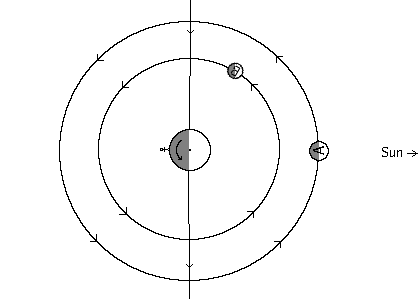 rotation of the planet brings the horizon up to cover Moon B a few
hours later, about 10 PM. By midnight, both moons are out of sight below the
horizon.
rotation of the planet brings the horizon up to cover Moon B a few
hours later, about 10 PM. By midnight, both moons are out of sight below the
horizon.
At
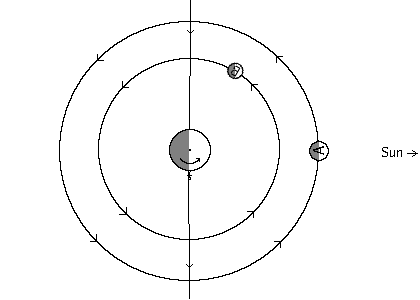 sunrise, the new Moon A rises as well, though it's invisibly dark and
obscured by the glare of the sun anyway. Moon B is still well below the
horizon, though, out of sight behind the planet.
sunrise, the new Moon A rises as well, though it's invisibly dark and
obscured by the glare of the sun anyway. Moon B is still well below the
horizon, though, out of sight behind the planet.
Moon
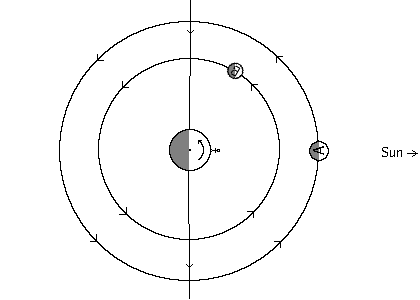 B's crescent rises about 10 AM, to join both the sun and the unseen Moon A
in the daytime sky. By noon, it's well above the horizon, and it spends the
rest of the day in the sky, not setting until after dark.
B's crescent rises about 10 AM, to join both the sun and the unseen Moon A
in the daytime sky. By noon, it's well above the horizon, and it spends the
rest of the day in the sky, not setting until after dark.
Eight
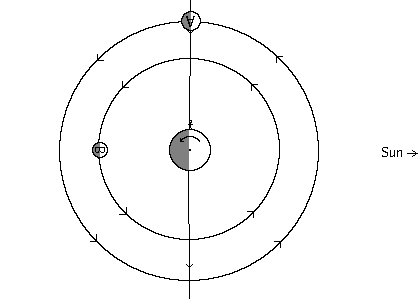 more days brings Moon B the rest of the way around to full again. The
laggard Moon A is only to the first quarter, though. When the sun is setting
in the west, the full Moon B is just rising in the east, and Moon A, only
half-lit, is directly over our observer's head.
more days brings Moon B the rest of the way around to full again. The
laggard Moon A is only to the first quarter, though. When the sun is setting
in the west, the full Moon B is just rising in the east, and Moon A, only
half-lit, is directly over our observer's head.
By
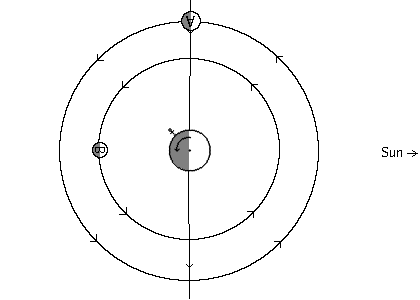 9 PM, it's full night, with the sun well below our observer's horizon. Both
moons are high in the sky, now, showing different phases, and far apart in
the sky. The full Moon B is in the eastern sky, about halfway between the
horizon and the zenith, the point directly above our observer's head. Moon
A, at first quarter, with the sunward half lit and the other half dark, is
in the western sky, also about halfway between the horizon and the zenith,
putting the two moons about ninety degrees apart.
9 PM, it's full night, with the sun well below our observer's horizon. Both
moons are high in the sky, now, showing different phases, and far apart in
the sky. The full Moon B is in the eastern sky, about halfway between the
horizon and the zenith, the point directly above our observer's head. Moon
A, at first quarter, with the sunward half lit and the other half dark, is
in the western sky, also about halfway between the horizon and the zenith,
putting the two moons about ninety degrees apart.
At
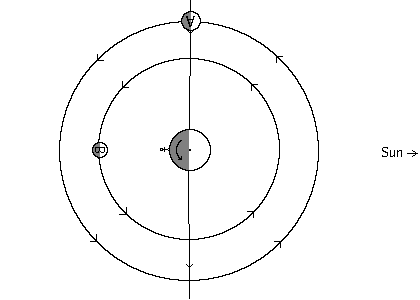 midnight, Moon A sets in the west. The planet's rotation has now brought
Moon B to the zenith.
midnight, Moon A sets in the west. The planet's rotation has now brought
Moon B to the zenith.
As
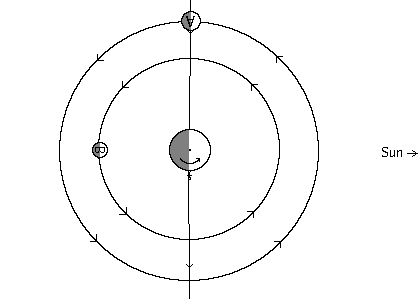 the sun rises, Moon B also sets.
the sun rises, Moon B also sets.
Skip
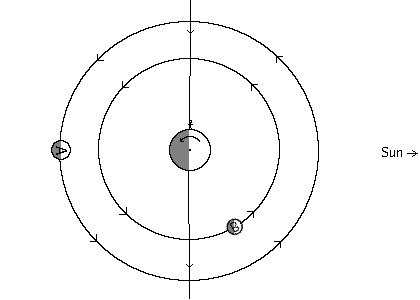 ahead a final eight days, and Moon A has moved opposite the sun again, and
grown back to full. Moon B is well ahead in its shorter orbit, though,
having moved around to where it's only a waning crescent. As the sun sets
where our observer is, he can't see Moon B, though. It's way around behind
the planet. Moon A, opposite the sun, rises on his eastern horizon as the
sun sets on his western horizon.
ahead a final eight days, and Moon A has moved opposite the sun again, and
grown back to full. Moon B is well ahead in its shorter orbit, though,
having moved around to where it's only a waning crescent. As the sun sets
where our observer is, he can't see Moon B, though. It's way around behind
the planet. Moon A, opposite the sun, rises on his eastern horizon as the
sun sets on his western horizon.
At
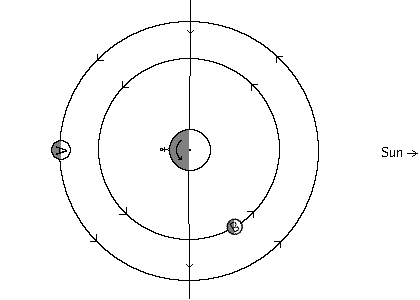 midnight, Moon A has risen so that its full disc is directly over our
observer's head. Moon B is still nowhere to be seen.
midnight, Moon A has risen so that its full disc is directly over our
observer's head. Moon B is still nowhere to be seen.
At
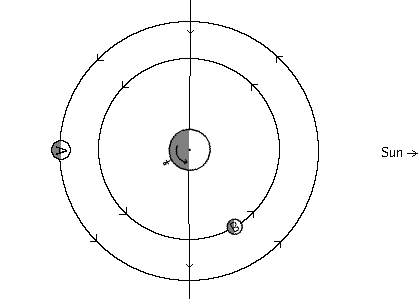 2 AM, Moon B's crescent is finally visible on the eastern horizon, its
rounded belly facing down towards the yet-unseen sun, and its horns pointing
up away from the sun. The full Moon A has passed the zenith and is dropping
towards the western horizon.
2 AM, Moon B's crescent is finally visible on the eastern horizon, its
rounded belly facing down towards the yet-unseen sun, and its horns pointing
up away from the sun. The full Moon A has passed the zenith and is dropping
towards the western horizon.
Moon
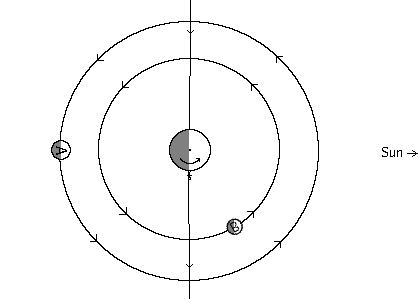 A, opposite the sun, sets in the west as the sun rises, leaving the crescent
of Moon B alone, still high in the increasingly bright sky.
A, opposite the sun, sets in the west as the sun rises, leaving the crescent
of Moon B alone, still high in the increasingly bright sky.
At
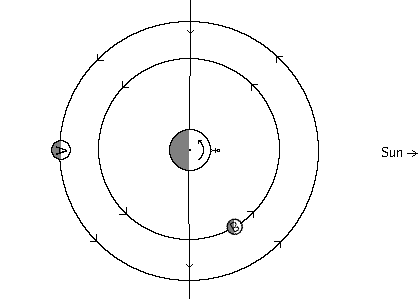 high noon where our observer is, the sun burns down from directly over his
head, and Moon B's crescent is still visible in the daytime sky, though now
low on the western horizon.
high noon where our observer is, the sun burns down from directly over his
head, and Moon B's crescent is still visible in the daytime sky, though now
low on the western horizon.
And that ought to pretty much do it. I could make
more diagrams, but they wouldn't really demonstrate anything new, so we'll
stop here.
So what we've learned here:
Moon phases are determined by where the moon is in its orbit, in relation
to the sun.
The moon can rise or set at any time of the day or night, and when the
moon rises and sets is also determined by where the moon is in its
orbit, in relation to the sun.
And, therefore, when it rises and sets is determined by its phase, and
vice versa. The one can be determined from the other, by the list above.
The moon can be and often is visible in the daytime sky, and can be and
often is absent from the night sky.
If there's more than one moon, their months will be of different lengths,
so their phases won't stay in sync with one another. Nor will their times of
rising and setting.
Moons at similar phases will be close together in the sky; moons at
different phases will be far apart in the sky.
But because the visible sky covers a full half of the celestial sphere,
you can still have two moons in the sky at the same time at very different
phases, even though they're far apart.
The lit side of a partial moon will always be oriented towards the sun,
even when the sun isn't visible in the sky from the surface.
Most moons always keep the same face towards their planet throughout the
month. This doesn't mean that they don't rotate, though. Rather, it means
that they rotate exactly once per revolution - their day is the same length
as the month.
And eclipses and occultings are less common than a two-dimensional
not-to-scale diagram might lead you to believe.
Left as an exercise for the reader is the question
of what these diagrams look like from the perspective of an observer living
on the moon... a moonbase on a moon like Luna, or an Earthlike moon
orbiting an even bigger planet like Jupiter, possibly one with other
significant moons.
Oh, yeah, and Mars? The Martian Moon B, Phobos,
orbits so low and fast that it takes it less than a third of a Martian day
(Martian days are only about forty minutes longer than Earth's) to complete
a full orbit around Mars. That means that it moves so fast that it overtakes
the Martian surface below it. It rises in the west and travels
west-to-east across the sky, contrary to the apparent motion of sun and
stars - and this is not just an illusion produced by the rotation of the
planet beneath it, but Phobos's actual orbital motion - changing phase
visibly as it goes, and sets about six hours later in the east, as it
overtakes the horizon and dives below it.
The Martian Moon A, Deimos, is not quite so fast, but is still fast
enough that it almost keeps up with Mars's rotation. It takes it only a
little more than a Martian day to complete an orbit, which means that the
Martian surface overtakes it only very slowly, gaining about a fifth of a
rotation each day. This means that Deimos rises in the east, but creeps
across the sky only slowly, and doesn't set in the west until two and half
days later, during which time it's gone through the entire moon cycle
twice.
Yeah, I said it was complicated.
 is a system like Earth-Luna. We're looking down at it from above the
North Pole. The sun is some distance off the right edge of the diagrams,
lighting everything from the right. The planet rotates counterclockwise,
making one full turn each day. The moon revolves around the planet, also
moving counterclockwise, but much more slowly... one complete revolution
every month.
is a system like Earth-Luna. We're looking down at it from above the
North Pole. The sun is some distance off the right edge of the diagrams,
lighting everything from the right. The planet rotates counterclockwise,
making one full turn each day. The moon revolves around the planet, also
moving counterclockwise, but much more slowly... one complete revolution
every month. now we'll advance a few hours into the future, to our stick figure's local
midnight. He's still standing in the same spot looking at the sky, but the
planet has rotated ninety degrees, carrying him with it. It's full night now
where he is, with the sun out of sight on the opposite side of the planet.
The moon, slow-moving as it is, has also stayed in very nearly the same
spot, but because the planet is rotating beneath it, it's now directly over
our observer's head. The face of it that's towards the planet is still the
face that's lit by the sun, so it's still a full moon.
now we'll advance a few hours into the future, to our stick figure's local
midnight. He's still standing in the same spot looking at the sky, but the
planet has rotated ninety degrees, carrying him with it. It's full night now
where he is, with the sun out of sight on the opposite side of the planet.
The moon, slow-moving as it is, has also stayed in very nearly the same
spot, but because the planet is rotating beneath it, it's now directly over
our observer's head. The face of it that's towards the planet is still the
face that's lit by the sun, so it's still a full moon. few more hours, and the rotation of the planet has carried our observer
clear around to the sunrise line. This has brought him back to where he can
see the sun, rising on his eastern horizon, but also carried him away from
the moon, which - again, despite not actually having moved significantly in
its orbit - is now low on his western horizon, setting. And still, as
before, full.
few more hours, and the rotation of the planet has carried our observer
clear around to the sunrise line. This has brought him back to where he can
see the sun, rising on his eastern horizon, but also carried him away from
the moon, which - again, despite not actually having moved significantly in
its orbit - is now low on his western horizon, setting. And still, as
before, full. few more hours, and our observer has been carried around so he's directly
beneath the sun. It's noon where he is, bright daylight with the sun
directly overhead. He can't see the moon - it's still there, still full, but
around on the other side of the planet, shining down on the antipodes, and
there's a ball of rock and iron thousands of kilometers thick blocking his
view of it.
few more hours, and our observer has been carried around so he's directly
beneath the sun. It's noon where he is, bright daylight with the sun
directly overhead. He can't see the moon - it's still there, still full, but
around on the other side of the planet, shining down on the antipodes, and
there's a ball of rock and iron thousands of kilometers thick blocking his
view of it. we're going to advance our clock by eight days here. Given the 32-day month,
that means that the moon will have traveled a quarter of the way around its
orbit. It's sunset again, and Mr. Stick Figure is standing in his usual
spot, looking at the sky. We can see, again, that he's at the terminator,
being carried from day into night by the planet's rotation. The sun is low on
his western horizon... but the moon is not rising as the sun sets. It is, in
fact, nowhere to be seen. It's moved in its orbit so it's no longer directly
opposite the sun, which means that when the sun sets on our observer, the
moon is clear around on the other side of the planet where he can't see
it.
we're going to advance our clock by eight days here. Given the 32-day month,
that means that the moon will have traveled a quarter of the way around its
orbit. It's sunset again, and Mr. Stick Figure is standing in his usual
spot, looking at the sky. We can see, again, that he's at the terminator,
being carried from day into night by the planet's rotation. The sun is low on
his western horizon... but the moon is not rising as the sun sets. It is, in
fact, nowhere to be seen. It's moved in its orbit so it's no longer directly
opposite the sun, which means that when the sun sets on our observer, the
moon is clear around on the other side of the planet where he can't see
it. observer waits a few hours, though, and, finally, at midnight, after six
hours of moonless night, the rotation of the planet carries him around to
where he can see the moon. It's now, at midnight, rising on the eastern
horizon. He's also no longer looking at the fully lit face. Because the moon
is beside the planet relative to the sun now instead of beyond it, the face
turned towards the planet is now only half lit, with the other half dark, in
the moon's own shadow. That makes it a quarter moon. (Yes, half-lit, quarter
moon... I didn't make up the terminology. It's because the moon is a quarter
of the way through its cycle.) Because it's waning - moving from full to new
- it is, specifically, the last quarter.
observer waits a few hours, though, and, finally, at midnight, after six
hours of moonless night, the rotation of the planet carries him around to
where he can see the moon. It's now, at midnight, rising on the eastern
horizon. He's also no longer looking at the fully lit face. Because the moon
is beside the planet relative to the sun now instead of beyond it, the face
turned towards the planet is now only half lit, with the other half dark, in
the moon's own shadow. That makes it a quarter moon. (Yes, half-lit, quarter
moon... I didn't make up the terminology. It's because the moon is a quarter
of the way through its cycle.) Because it's waning - moving from full to new
- it is, specifically, the last quarter. hours later, the moon has climbed high in the sky - again, not because of
its own movement, but because of the rotation of the planet beneath it. It's
directly overhead - still half-lit and half-dark - when the planet's
rotation carries our observer back around to the dawn terminator, and the
sun begins to peek over his eastern horizon.
hours later, the moon has climbed high in the sky - again, not because of
its own movement, but because of the rotation of the planet beneath it. It's
directly overhead - still half-lit and half-dark - when the planet's
rotation carries our observer back around to the dawn terminator, and the
sun begins to peek over his eastern horizon. a shorter-than-usual interval - about three hours; it's about 9 AM where our
observer is - we can see that the sun is well up in his sky. It's broad
daylight now. The moon is also still well up in his sky, though
no longer directly overhead. He'll be able to see here its lit portion hanging
in a blue sky.
a shorter-than-usual interval - about three hours; it's about 9 AM where our
observer is - we can see that the sun is well up in his sky. It's broad
daylight now. The moon is also still well up in his sky, though
no longer directly overhead. He'll be able to see here its lit portion hanging
in a blue sky. noon, when the sun is directly over our observer's head, the moon is finally
setting in the west, having been visible in the daytime sky all morning.
noon, when the sun is directly over our observer's head, the moon is finally
setting in the west, having been visible in the daytime sky all morning. we skip ahead another eight days. The moon revolves another quarter of the
way around the planet. It's now between the planet and the sun. Probably not
directly between... like the full moon, on the rare occasions that
the new moon is directly in line with the planet and the sun, it produces an
eclipse. A solar eclipse, in this case. But usually it's not directly in
line, but a little above or below, and thus eclipses are uncommon, and don't
occur every new moon.
we skip ahead another eight days. The moon revolves another quarter of the
way around the planet. It's now between the planet and the sun. Probably not
directly between... like the full moon, on the rare occasions that
the new moon is directly in line with the planet and the sun, it produces an
eclipse. A solar eclipse, in this case. But usually it's not directly in
line, but a little above or below, and thus eclipses are uncommon, and don't
occur every new moon. moon having set with the sun at dusk, there's nothing but the stars in the
sky at night. The sun and moon are both on the far side of the planet,
unseen.
moon having set with the sun at dusk, there's nothing but the stars in the
sky at night. The sun and moon are both on the far side of the planet,
unseen. sunrise rolls around again, the moon, still near the sun in the (now)
eastern sky, rises right along with it.
sunrise rolls around again, the moon, still near the sun in the (now)
eastern sky, rises right along with it. at noon, when the sun is high in the daytime sky, the moon is right there
with it, directly overhead. Because it's new, though, the lit side away from
the planet, it'll show only a thin crescent, if anything at all, and even
that is likely invisible in the brilliant glare of the sun.
at noon, when the sun is high in the daytime sky, the moon is right there
with it, directly overhead. Because it's new, though, the lit side away from
the planet, it'll show only a thin crescent, if anything at all, and even
that is likely invisible in the brilliant glare of the sun. eight days will bring the moon around another quarter-turn. It's now
directly overhead at sunset, with half of it - the other half, this time -
lit by the sun. This makes it a quarter moon again (I told you, I didn't
make up the terminology here) - this time, the first quarter.
eight days will bring the moon around another quarter-turn. It's now
directly overhead at sunset, with half of it - the other half, this time -
lit by the sun. This makes it a quarter moon again (I told you, I didn't
make up the terminology here) - this time, the first quarter. at midnight, the moon sets.
at midnight, the moon sets. the rest of the night is moonless. When the sun rises on our observer, the
moon is on the opposite side of the planet from him.
the rest of the night is moonless. When the sun rises on our observer, the
moon is on the opposite side of the planet from him. moon rises at midday, though, when the sun is directly overhead, and through
the afternoon it climbs higher in the sky until it's in turn directly
overhead when sunset rolls around again.
moon rises at midday, though, when the sun is directly overhead, and through
the afternoon it climbs higher in the sky until it's in turn directly
overhead when sunset rolls around again.

 Just like our single-moon world, here both moons are full,
and rise together at sunset, set together at sunrise, and are directly
overhead at midnight.
Just like our single-moon world, here both moons are full,
and rise together at sunset, set together at sunrise, and are directly
overhead at midnight. This means that eight days after the previous set of diagrams, Moon A will
have moved a quarter of the way around its orbit, and be in the last
quarter, as when it was the only moon. Eight days is a third of
Moon B's orbital period, however, so it will have moved a third of the way
around its orbit, and pulled ahead of Moon A.
This means that eight days after the previous set of diagrams, Moon A will
have moved a quarter of the way around its orbit, and be in the last
quarter, as when it was the only moon. Eight days is a third of
Moon B's orbital period, however, so it will have moved a third of the way
around its orbit, and pulled ahead of Moon A. midnight, the rotation of the planet brings our observer around so that Moon
A is just rising above his horizon. As before, it's last quarter, half of
the near face lit and half of it dark. Moon B, being a little further along,
is still below the horizon, out of sight, however.
midnight, the rotation of the planet brings our observer around so that Moon
A is just rising above his horizon. As before, it's last quarter, half of
the near face lit and half of it dark. Moon B, being a little further along,
is still below the horizon, out of sight, however. 2 AM, the planet has rotated far enough that Moon B also clears the eastern
horizon. Moon A, having been up for a couple of hours, is about thirty
degrees above the horizon when Moon B is just rising. Moon B is also
somewhat past the last-quarter position. The face of it that's towards the
planet, towards the observer, is not half-and-half, but more dark than
light. It's not a quarter moon, it's a fat crescent. As it rises, we now
have two moons in our observer's sky, in different spots, and in slightly
but distinctly different phases.
2 AM, the planet has rotated far enough that Moon B also clears the eastern
horizon. Moon A, having been up for a couple of hours, is about thirty
degrees above the horizon when Moon B is just rising. Moon B is also
somewhat past the last-quarter position. The face of it that's towards the
planet, towards the observer, is not half-and-half, but more dark than
light. It's not a quarter moon, it's a fat crescent. As it rises, we now
have two moons in our observer's sky, in different spots, and in slightly
but distinctly different phases. the sun rises a few hours later, Moon A is directly overhead, still at its
last quarter, and the waning crescent of Moon B is high in the eastern sky
and climbing.
the sun rises a few hours later, Moon A is directly overhead, still at its
last quarter, and the waning crescent of Moon B is high in the eastern sky
and climbing. noon, Moon A sets in the west, leaving Moon B still above the western
horizon, a fat crescent with its rounded belly facing upwards towards the
sun and its horns pointed down at the horizon. Moon B follows A down a
couple hours later, as the sun is beginning to slide down the western
sky.
noon, Moon A sets in the west, leaving Moon B still above the western
horizon, a fat crescent with its rounded belly facing upwards towards the
sun and its horns pointed down at the horizon. Moon B follows A down a
couple hours later, as the sun is beginning to slide down the western
sky. we skip ahead another eight days. This brings Moon A another quarter of the
way around its orbit to new, and Moon B another third of the way around -
almost, but not quite, to the first quarter. When our observer looks up at
dusk, Moon A, dark and invisible, is setting in the west with the sun. Moon
B is still above the horizon, and partly lit, not quite half lit. It's the
same fat crescent as eight days earlier, in fact, but on the other side
now... waxing instead of waning.
we skip ahead another eight days. This brings Moon A another quarter of the
way around its orbit to new, and Moon B another third of the way around -
almost, but not quite, to the first quarter. When our observer looks up at
dusk, Moon A, dark and invisible, is setting in the west with the sun. Moon
B is still above the horizon, and partly lit, not quite half lit. It's the
same fat crescent as eight days earlier, in fact, but on the other side
now... waxing instead of waning. rotation of the planet brings the horizon up to cover Moon B a few
hours later, about 10 PM. By midnight, both moons are out of sight below the
horizon.
rotation of the planet brings the horizon up to cover Moon B a few
hours later, about 10 PM. By midnight, both moons are out of sight below the
horizon. sunrise, the new Moon A rises as well, though it's invisibly dark and
obscured by the glare of the sun anyway. Moon B is still well below the
horizon, though, out of sight behind the planet.
sunrise, the new Moon A rises as well, though it's invisibly dark and
obscured by the glare of the sun anyway. Moon B is still well below the
horizon, though, out of sight behind the planet. B's crescent rises about 10 AM, to join both the sun and the unseen Moon A
in the daytime sky. By noon, it's well above the horizon, and it spends the
rest of the day in the sky, not setting until after dark.
B's crescent rises about 10 AM, to join both the sun and the unseen Moon A
in the daytime sky. By noon, it's well above the horizon, and it spends the
rest of the day in the sky, not setting until after dark. more days brings Moon B the rest of the way around to full again. The
laggard Moon A is only to the first quarter, though. When the sun is setting
in the west, the full Moon B is just rising in the east, and Moon A, only
half-lit, is directly over our observer's head.
more days brings Moon B the rest of the way around to full again. The
laggard Moon A is only to the first quarter, though. When the sun is setting
in the west, the full Moon B is just rising in the east, and Moon A, only
half-lit, is directly over our observer's head. 9 PM, it's full night, with the sun well below our observer's horizon. Both
moons are high in the sky, now, showing different phases, and far apart in
the sky. The full Moon B is in the eastern sky, about halfway between the
horizon and the zenith, the point directly above our observer's head. Moon
A, at first quarter, with the sunward half lit and the other half dark, is
in the western sky, also about halfway between the horizon and the zenith,
putting the two moons about ninety degrees apart.
9 PM, it's full night, with the sun well below our observer's horizon. Both
moons are high in the sky, now, showing different phases, and far apart in
the sky. The full Moon B is in the eastern sky, about halfway between the
horizon and the zenith, the point directly above our observer's head. Moon
A, at first quarter, with the sunward half lit and the other half dark, is
in the western sky, also about halfway between the horizon and the zenith,
putting the two moons about ninety degrees apart. midnight, Moon A sets in the west. The planet's rotation has now brought
Moon B to the zenith.
midnight, Moon A sets in the west. The planet's rotation has now brought
Moon B to the zenith. the sun rises, Moon B also sets.
the sun rises, Moon B also sets. ahead a final eight days, and Moon A has moved opposite the sun again, and
grown back to full. Moon B is well ahead in its shorter orbit, though,
having moved around to where it's only a waning crescent. As the sun sets
where our observer is, he can't see Moon B, though. It's way around behind
the planet. Moon A, opposite the sun, rises on his eastern horizon as the
sun sets on his western horizon.
ahead a final eight days, and Moon A has moved opposite the sun again, and
grown back to full. Moon B is well ahead in its shorter orbit, though,
having moved around to where it's only a waning crescent. As the sun sets
where our observer is, he can't see Moon B, though. It's way around behind
the planet. Moon A, opposite the sun, rises on his eastern horizon as the
sun sets on his western horizon. midnight, Moon A has risen so that its full disc is directly over our
observer's head. Moon B is still nowhere to be seen.
midnight, Moon A has risen so that its full disc is directly over our
observer's head. Moon B is still nowhere to be seen. 2 AM, Moon B's crescent is finally visible on the eastern horizon, its
rounded belly facing down towards the yet-unseen sun, and its horns pointing
up away from the sun. The full Moon A has passed the zenith and is dropping
towards the western horizon.
2 AM, Moon B's crescent is finally visible on the eastern horizon, its
rounded belly facing down towards the yet-unseen sun, and its horns pointing
up away from the sun. The full Moon A has passed the zenith and is dropping
towards the western horizon. A, opposite the sun, sets in the west as the sun rises, leaving the crescent
of Moon B alone, still high in the increasingly bright sky.
A, opposite the sun, sets in the west as the sun rises, leaving the crescent
of Moon B alone, still high in the increasingly bright sky. high noon where our observer is, the sun burns down from directly over his
head, and Moon B's crescent is still visible in the daytime sky, though now
low on the western horizon.
high noon where our observer is, the sun burns down from directly over his
head, and Moon B's crescent is still visible in the daytime sky, though now
low on the western horizon.